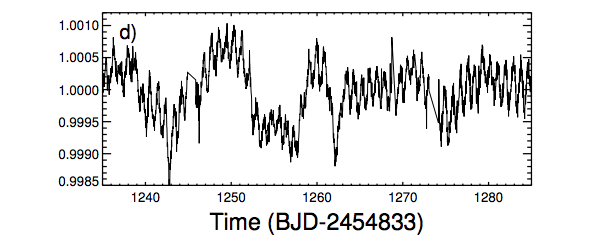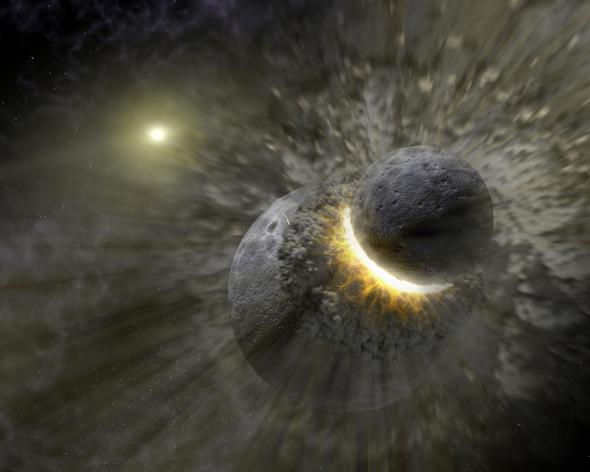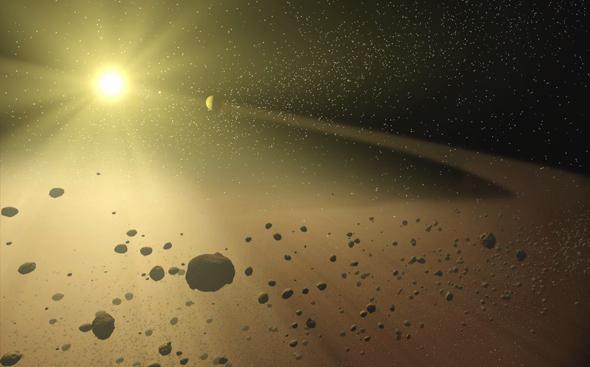A paper by a team of astronomers is getting some notice because of aliens.
Now let’s have a care here. The paper doesn’t mention aliens, and it doesn’t even imply aliens. Not directly, at least. But the astronomers found a star so odd, with behavior so difficult to explain, that it’s clear something weird is happening there. And some of the astronomers who did the work are now looking into the idea that what they’ve found might (might!) be due to aliens.
But don’t let this idea run away with you (as it has with some folks on social media and, no doubt, will in some sketchier “media” outlets any minute now). The scientists involved are being very skeptical and approaching this the right way: more of an interested “Hey, why not?” follow-up, as opposed to the Hollywood renegade astronomer who just knows it’s aliens but (fist shaking in the air) just can’t convince those uptight Big Astro sellouts!
But it’s cool either way.
OK, so first, what’s the science?
The star is called KIC 8462852, and it’s one of more than a hundred thousand stars that was observed by NASA’s Kepler mission. Kepler stared at these stars, looking for dips in their brightness. These very slight dimmings can be due to many factors, but one is if the star has planets, and one (or more) of them orbits the star in such a way that it passes directly in front of the star as seen from Earth. If it does—what we call a transit—we see a tiny diminution of starlight, usually by less than a percent.
Thousands of exoplanets have been found this way. Usually the planet is on a short orbit, so the dip we see is periodic, repeating every few days, weeks, or months, depending on the size of the planet’s orbit.
KIC 8462852 is a star somewhat more massive, hotter, and brighter than the Sun. It’s about 1,500 light-years away, a decent distance, so it’s too faint to see with the naked eye. The Kepler data for the star are pretty bizarre: There are dips in the light, but they aren’t periodic. They can be very deep; one dropped the amount of starlight by 15 percent, and another by a whopping 22 percent!

Graphs by Boyajian et al.
Straight away, we know we’re not dealing with a planet here. Even a Jupiter-sized planet only blocks roughly 1 percent of this kind of star’s light, and that’s about as big as a planet gets. It can’t be due to a star, either; we’d see it if it were. And the lack of a regular, repeating signal belies both of these as well. Whatever is blocking the star is big, though, up to half the width of the star itself!
Also, it turns out there are lots of these dips in the star’s light. Hundreds. And they don’t seem to be periodic at all. They have odd shapes to them, too. A planet blocking a star’s light will have a generally symmetric dip; the light fades a little, remains steady at that level, then goes back up later. The dip at 800 days in the KIC 8462852 data doesn’t do that; it drops slowly, then rises more rapidly. Another one at 1,500 days has a series of blips up and down inside the main dips. There’s also an apparent change in brightness that seems to go up and down roughly every 20 days for weeks, then disappears completely. It’s likely just random transits, but still. It’s bizarre.

Graphs by Boyajian et al.
The authors of the paper went to some trouble to eliminate obvious causes. It’s not something in the telescope or the processing; the dips are real. It’s not due to starspots (like sunspots, but on another star). My first thought was some sort of planetary collision, like the impact that created the Moon out of the Earth billions of years ago; that would create a lot of debris and dust clouds. These chunks and clouds orbiting the star would then cause a series of transits that could reproduce what’s seen.

Drawing by NASA/JPL-Caltech/T. Pyle (SSC)
The problem with that is that there’s no excess of infrared light from the star. Dust created in such impacts warms up and glows in the IR. We know how much IR stars like KIC 8462852 give off, and we see just the right amount from it, no more. The lack of that glow means no (or very little) dust.
The last idea the astronomers looked at was a series of comets orbiting the star. These could be surrounded by clouds of gas and other material that could produce the dips seen. The lack of IR is puzzling in that case, but not too damning. If another star happened to pass nearby, then its gravity could disturb the first star’s Oort cloud, the region billions of kilometers out where we think most (if not all) stars have billions of icy objects. This disturbance could send these ice chunks flying down toward the star, where they could break up, creating all those weird dips—ices in them would heat up, blow off as a gas, and could explain the odd shapes of the dips detected, too.
And, as it happens, there is another star pretty close to KIC 8462852; a small red dwarf about 130 billion kilometers out. That’s close enough to affect the Oort cloud.
This doesn’t close the case, though. Comets are a good guess, but it’s hard to imagine a scenario where they could completely block 22 percent of the light from a star; that’s a huge amount. Really huge.
So where does that leave us?
Wondering if there might be more to this, Tabetha Boyajian, the lead author on the paper, showed the results to Jason Wright, an astronomer who studies exoplanets and, not coincidentally, has researched how to look for signatures of advanced alien civilizations in Kepler data.
Yes, seriously.
Get this:
Look at our own civilization. We consume ever-increasing amounts of power, and are always looking for bigger sources. Fossil, nuclear, solar, wind … Decades ago, physicist Freeman Dyson popularized an interesting idea: What if we built thousands of gigantic solar panels, kilometers across, and put them in orbit around the Sun? They’d capture sunlight, convert it to energy, and that could be beamed to Earth for our use. Need more power? Build more panels! An advanced civilization could eventually build millions, billions of them.
This idea evolved into what’s called a Dyson Sphere, a gigantic sphere that completely encloses a star. It was popular back in the 1970s and 80s; there was even an episode of Star Trek: The Next Generation about one. Dyson never really meant that we’d build an actual sphere; just lots of little panels that might mimic one.
But it raises an interesting possibility for detecting alien life. Such a sphere would be dark in visible light but emit a lot of infrared. People have looked for them, but we’ve never seen one (obviously).
Which brings us back to KIC 8462852. What if we caught an advanced alien civilization in the process of building such an artifact? Huge panels (or clusters of them) hundreds of thousands of kilometers across, and oddly-shaped, could produce the dips we see in that star’s light.
Now I imagine some of you might expect me to rail against this idea, call it ridiculous, and pooh-pooh the notion of aliens and all that

This photo is an Internet meme and is everywhere. This specific instance is from Quickmeme.
Well, surprise! I actually kinda like it. I’m not saying it’s right, mind you, just that it’s interesting. Wright isn’t some wild-eyed crackpot; he’s a professional astronomer with a solid background. As he told me when I talked to him over the phone, there’s “a need to hypothesize, but we should also approach it skeptically” (paraphrasing a tweet by another astronomer, David Grinspoon), with which I wholeheartedly agree.
Look, I think it’s pretty obvious this scenario is, um, unlikely. But hey, why not? It’s easy enough to get follow-up observations of the star to check the idea out. It’s low probability but high stakes, so probably worth a shot. And it’s not exactly science fiction; Wright and a few other astronomers have submitted a paper (pending publication) to the prestigious Astrophysical Journal examining the physics of these structures and detailing how they could be detected around other stars.
As reported in the Atlantic (which is what started all the social media interest in the first place), Wright and Boyajian are indeed proposing to use a radio telescope to look for signals from the star. An alien civilization building such a structure might leak (or broadcast!) radio waves that could be detectable from 1,500 light-years away. That’s the whole basis of SETI, the Search for Extraterrestrial Intelligence (see the movie Contact, or better yet read the book, for more on this). Telescope time is controlled by a committee, and it’s not clear if the proposal will pass or not. I hope so; it shouldn’t take too much telescope time, and under modest assumptions it shouldn’t be too hard to detect a signal.
If one exists. This is still a very, very long shot. But again, this isn’t a huge effort costing zillions of dollars. The effort is minimal, but the payoff could be pretty big. Also, radio observations of the star might prove useful in solving the mystery, even if it’s not aliens. Which, I’ll reiterate, it really likely isn’t.
I would also support follow-up observations (as indicated in the Boyajian paper) looking for signals from comets. Some molecules in comets glow quite brightly when comets get near a star, and that signal may not be too difficult to detect either. Also, there could simply be natural possibilities no one has thought of yet. More observations means stirring the pot a little more and could inspire new thinking.
Whether there are aliens constructing huge megastructures to feed their power needs at KIC 8462852, or—overwhelmingly more likely—it’s a more natural scenario, this is a pretty weird and interesting star. And it’s definitely worth investigating further.
Read more in Bad Astronomy:
- Aliens? Yes. UFOs? No.
- Has Alien Life Been Found in Earth’s Atmosphere? I’m Gonna Go With “No.”
- Astronomer Seth Shostak Says We May Find Aliens Within 20 Years
- Life Found in a Meteorite? Spoiler: No.
- New Study Shows There May Be a Hundred Billion Planets in Our Galaxy
- Crash Course Astronomy: Exoplanets
*Correction, Oct 14. 2015, at 13:45 UTC: I originally implied that the Kepler spacecraft was still observing this star, but in 2014 the mission was retooled for a somewhat different purpose and renamed to K2. At that point, KIC 8462852 was no longer being observed.
